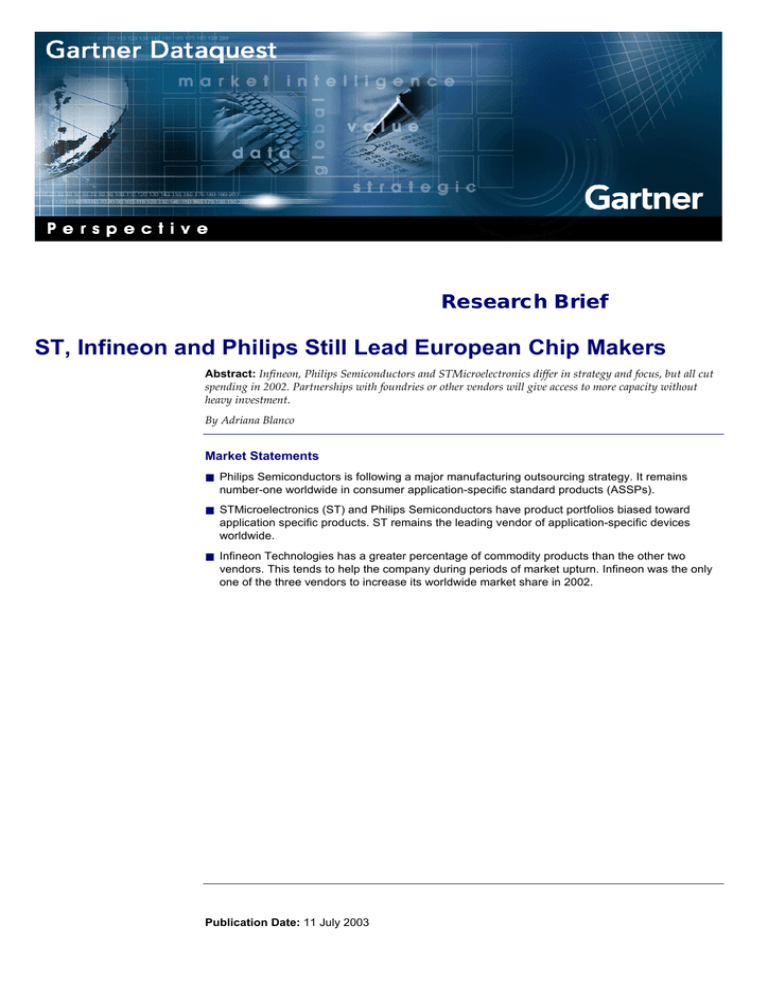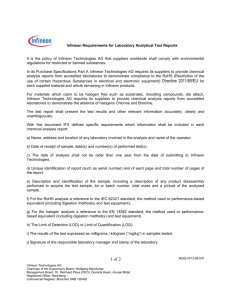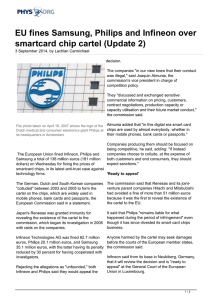
Research Brief
ST, Infineon and Philips Still Lead European Chip Makers
Abstract: Infineon, Philips Semiconductors and STMicroelectronics differ in strategy and focus, but all cut
spending in 2002. Partnerships with foundries or other vendors will give access to more capacity without
heavy investment.
By Adriana Blanco
Market Statements
■ Philips Semiconductors is following a major manufacturing outsourcing strategy. It remains
number-one worldwide in consumer application-specific standard products (ASSPs).
■ STMicroelectronics (ST) and Philips Semiconductors have product portfolios biased toward
application specific products. ST remains the leading vendor of application-specific devices
worldwide.
■ Infineon Technologies has a greater percentage of commodity products than the other two
vendors. This tends to help the company during periods of market upturn. Infineon was the only
one of the three vendors to increase its worldwide market share in 2002.
Publication Date: 11 July 2003
2
ST, Infineon and Philips Still Lead European Chip Makers
Vendor Rankings
Semiconductor vendors based in Europe, the Middle East and Africa (EMEA)
maintained their share of 11.3 percent of the worldwide semiconductor market in
2002. ST maintained the lead and Infineon Technologies moved up to second place,
thanks to growth from dynamic random-access memory (DRAM). Philips
Semiconductors dropped to third place. All three are among the top 10 worldwide
semiconductor vendors.
Highlights of their performance in 2002:
■
Their combined share of the EMEA market improved slightly, from 21.4 percent
in 2001 to 21.9 percent.
■
Their combined share of the worldwide market increased from 9.9 percent in 2001
to 10.2 percent.
■
Infineon experienced double-digit growth on its worldwide revenue, moving up
to number seven from number 10 in 2001 in the worldwide rankings.
■
ST fell one place to rank fourth worldwide, as a result of Samsung's strong
performance, which climbed to second place because of strong revenue growth in
DRAM.
■
Philips Semiconductors retained ninth place in the worldwide rankings.
Although overall revenue dropped slightly, Philips remained the leading vendor
of consumer ASSPs.
For full details of vendor revenue generated from semiconductor shipments to
EMEA in 2002, and our methodology and assumptions, please see "Semiconductor
Vendor Market Shares: EMEA, 2002," SCSI-WW-MS-0180.
Table 1 shows the rankings for the top 10 EMEA-based companies by worldwide
revenue in 2002.
Table 1
Top 10 Semiconductor Vendors Based in EMEA — by Worldwide Revenue, 2001 and 2002
Rank
2001
Rank
2002
Vendor
2001 Revenue
($M)
2002 Revenue
($M)
Percentage
Change
2001 Market
Share
2002 Market
Share
1
1
STMicroelectronics
$6,365
$6,355
-0.2%
4.2%
4.1%
3
2
Infineon Technologies
$4,328
$5,253
21.4%
2.8%
3.4%
2
3
Philips Semiconductors
$4,402
$4,361
-0.9%
2.9%
2.8%
4
4
Robert Bosch
$520
$592
13.8%
0.3%
0.4%
5
5
Micronas Intermetall
$347
$464
33.7%
0.2%
0.3%
6
6
EM Microelectronic-Marin
$141
$130
-7.8%
0.1%
0.1%
9
7
Melexis
$90
$112
24.4%
0.1%
0.1%
8
8
Elmos Semiconductors
$95
$92
-3.2%
0.1%
0.1%
11
9
Austria Microsystems
$89
$82
-7.9%
0.1%
0.1%
12
10
Zetex
$72
$81
12.5%
0.0%
0.1%
Others
$136,743
$138,635
1.4%
89.3%
88.8%
Total
$153,192
$156,157
1.9%
100.0%
100.0%
50.7%
Distribution of Revenue and Market Share, by Location of Company Headquarters
Americas
$80,078
$79,096
-1.2%
52.3%
Japan
$41,873
$41,219
-1.6%
27.3%
26.4%
Europe
$17,213
$17,671
2.7%
11.2%
11.3%
$14,028
$18,171
29.5%
9.2%
11.6%
Asia/Pacific
Source: Gartner Dataquest (July 2003)
©2003 Gartner, Inc. and/or its Affiliates. All Rights Reserved.
11 July 2003
3
Strongest Revenue Growth From Asia/Pacific
The top three EMEA vendors have a broad product portfolio and account for a large
portion of worldwide sales. This works well during a downturn, because this
variety helps to dampen the effects of any single factor. However, during an upturn
some products or regional markets might not grow quickly.
Infineon's revenue generated from memory, mostly DRAM, accounted for 36
percent of its worldwide total in 2002, compared with 26.5 percent in 2001. This
reflected growth of 70.6 percent for Infineon's DRAM revenue in 2002, fueled by
strong bit growth. Application-specific devices for wireless applications also saw
strong growth. Microcontrollers for smart cards were affected by low average
selling prices (ASPs). EMEA accounted for 47 percent of the company's global sales,
but the strongest growth came from Asia/Pacific.
Nearly 60 percent of Philips Semiconductors' sales came from application-specific
devices in 2002, a slight increase from 58 percent in 2001, with consumer ASSPs
accounting for more than half of sales. Philips Semiconductors remains strong in the
consumer segment, thanks to its road map to integrate semiconductor devices for
consumer applications and its pricing strategy for electronic equipment
manufacturers. The company also has a large market share in the TV set industry.
The company's sales to most world regions declined in 2002, apart from
Asia/Pacific, which grew by more than 30 percent.
ST's revenue from application-specific devices accounted for 61 percent of its
worldwide sales in 2002, a small increase from 58 percent in 2001. This kept the
company in the top spot in the worldwide application-specific device rankings,
ahead of Texas Instruments. Memory sales continued to decline in 2002, reflecting
the difficult pricing environment for flash memory.
Figures 1 and 2 present worldwide revenue for Infineon, Philips Semiconductors
and ST by device and by region in 2002. Sales of application-specific devices
accounted for a large part of their revenue. Revenue from EMEA and Asia/Pacific
accounted for more than 70 percent of total sales for the three European vendors.
Figure 1
Top Three EMEA Semiconductor Vendors — Worldwide Revenue by Device, 2002
Percentage
70%
Infineon Technologies
60%
Philips
Semiconductors
50%
STMicroelectronics
40%
30%
20%
or
S
s
en
s
T
sp ota
ec l a
ifi pp
c lic
de a
vi tio
ce ns
T
se
m
-p
al
er
ro
ic
M
i
ld
a
ot
e
on Op
du tic
ct al
or
s
ur
p
m
co
et
r
sc
ic
s
en
nt
e
on
G
y
or
en
M
em
G
0%
po
lo se
gi
er
c
al
-p
ur
an pos
al e
og
10%
115954-00-01
Source: Gartner Dataquest (July 2003)
©2003 Gartner, Inc. and/or its Affiliates. All Rights Reserved.
11 July 2003
4
ST, Infineon and Philips Still Lead European Chip Makers
Figure 2
Top Three EMEA Semiconductor Vendors — Worldwide Revenue by Region, 2002
Percentage
50%
Infineon
Technologies
45%
Philips
Semiconductors
40%
35%
STMicroelectronics
30%
25%
20%
15%
10%
5%
0%
Americas
Japan
EMEA
Asia/Pacific
115954-00-02
Source: Gartner Dataquest (July 2003)
Semiconductor Capital Spending and Manufacturing
Revenue remained flat in 2002, and the semiconductor industry saw further cuts in
capital spending. Infineon continued to invest in 300-mm manufacturing, but cut
spending in 2002. The company has opted to enter into partnerships with foundries
to cater for future capacity increases without heavy investment. Philips
Semiconductors has consistently underinvested compared with the market average
and it is planning to increase its use of foundries. ST has a more flexible approach to
spending, compared with the other two companies. However, the company reduced
its spending drastically in 2002.
Table 2 highlights the major manufacturing activities for the top three EMEA
vendors during 2002.
©2003 Gartner, Inc. and/or its Affiliates. All Rights Reserved.
11 July 2003
5
Table 2
Top Three EMEA Semiconductor Vendors: Capital Expenditure and Manufacturing Activities in
2002
Infineon
Technologies
Capex
2002 ($B)
Estimated
Capex 2003 ($B)
$0.7
$1.0
Key Projects
Delays, Closures and Sales
Infineon entered into a joint venture
production with Nanya Technology on May
2002 to develop 90-nanometer and 70nanometer technologies on 300-mm wafers
Plans on hold for expansion in the White
Oak fab in Richmond, Virginia, United
States
Announced cost crossover for manufacturing
on 300-mm technology vs. 200-mm for DRAM
devices in Dresden, Germany in December
2002
The company halted its partnership with
Mosel Vitelic in Taiwan, the joint venture
known as ProMOS On October 2002
Continued its partnership with UMC on a
300-mm fab in Singapore
Philips
Semiconductors
$0.4
$0.4
300mm-line joint venture with ST and
Motorola in Crolles, France
Continuous investment in joint-venture
manufacturing facility, known as Systems on
Silicon Manufacturing Company (SSMC),
with Taiwan Semiconductor Manufacturing
Corporation (TSMC) and the Economic
Development Board Investments in Singapore
STMicroelectronics
$1.0
$1.0
300mm-line joint venture with Philips and
Motorola in Crolles, France
Started building a new 300-mm facility in
Catania, Italy, which was originally scheduled
for completion in 2002
Phasing out fabs in Albuquerque and San
Antonio, United States. Expected to close
by the end of 2003
Closure of the fab in Ottawa, Canada,
and the fab in Rancho Bernardo, United
States
Source: Gartner Dataquest (July 2003)
The spending-to-revenue ratio for the worldwide semiconductor industry declined
to 17.9 percent. The top three EMEA semiconductor vendors had ratios below the
worldwide level.
Figure 3 shows the ratio of worldwide semiconductor capital spending to revenue
for Infineon, Philips Semiconductors, ST and the semiconductor industry overall,
from 1990 to 2002.
©2003 Gartner, Inc. and/or its Affiliates. All Rights Reserved.
11 July 2003
6
ST, Infineon and Philips Still Lead European Chip Makers
Figure 3
Semiconductor Vendors' Ratio of Worldwide Semiconductor Capital Spending to Revenue, 19902002
Percentage
60%
Philips
Semiconductors
50%
STMicroelectronics
40%
Infineon
Technologies
30%
Worldwide
20%
10%
0%
1990 1991 1992 1993 1994 1995 1996 1997 1998 1999 2000 2001 2002
115954-00-03
Source: Gartner Dataquest (July 2003)
Alliances, Divestments and Acquisitions
The major activities of the EMEA top three in terms of alliances, divestments and
acquisitions during 2002 are presented in Table 3.
©2003 Gartner, Inc. and/or its Affiliates. All Rights Reserved.
11 July 2003
7
Table 3
Top Three EMEA Semiconductor Vendors Major Alliances, Divestments and Acquisitions
Infineon
Technologies
Alliances
Divestments
Acquisitions
Continued partnership with United Microelectronics
Corporation (UMC) to build a 300-mm fab in
Singapore.
Sold GaAs
business in July
2002 to TriQuint
Semiconductor
Acquired the Bluetooth and Mobile
Infrastructure devices and design activities of
Ericsson Microelectronics in June 2002, as well
as some back-end activities (module
assembly), which includes 700 employees. The
deal does not include the wafer fabrication
plants that Ericsson owns in Sweden.
Joint venture formed with AMD and DuPont
Photomask in May 2002, to form Advanced Mask
Technology Center (AMTC) to develop and pilotmanufacture next-generation lithographic
photomasks.
Entered into joint-venture production with Nanya
Technology in November 2002 to develop 90nanometer and 70-nanometer technologies on 300mm wafers.
Signed cooperation agreement with Semiconductor
Manufacturing International Corporation (SMIC) of
Shanghai, China, in December 2002, on the
production of dynamic random-access memory
(DRAM). Under the terms of the agreement, Infineon
will transfer its 0.14-micron DRAM trench technology
to SMIC. In return, SMIC will manufacture DRAM on
the 0.14-micron process exclusively for Infineon.
Philips
Semiconductor
Continues its joint venture, SSMC, with TSMC in
Singapore.
300mm-line joint venture with ST and Motorola to
develop new 90-nanometer CMOS process and nextgeneration 65-nanometer and lower technologies in
Crolles, France, with TSMC.
May 2002, alliance with Dai Nippon Printing (DNP)
for the development and supply of high-end
photomasks.
STMicroelectronics
300mm-line joint venture with Philips Semiconductor
and Motorola to develop new 90-nanometer CMOS
process and next-generation 65-nanometer and lower
technologies in Crolles, France, with TSMC.
Acquired Alcatel Microelectronics in April
2002, retaining the digital subscriber line (DSL)
business and selling the mixed-signal part of it
to AMI Semiconductor.
Extended manufacturing relationship with UMC in
July 2002, by signing a multiyear manufacturing
agreement, which also includes cooperation on
manufacturing science.
Source: Gartner Dataquest (June 2003)
Gartner Dataquest Perspective
Infineon, Philips Semiconductors and ST have very different strategies. The three
companies have broad product portfolios and worldwide sales.
Semiconductor vendors must focus on long-term strategies and, if possible,
maintain investment in R&D to remain competitive when the market recovers.
Infineon followed an "invest in a downturn" strategy, whereas ST has been more
flexible and Philips Semiconductors has been much more cautious with its
spending. However, all three European vendors reduced their capital spending in
2002.
Infineon is exposed to the volatile DRAM market. Consequently it had increased
revenue from strong bit growth in 2002. The company also saw improvement in
revenue of its wireless products. It claims that its strategy of leading-edge
manufacturing has helped it reduce costs. Throughout 2002, Infineon also focused
on forging partnerships that will give it access to manufacturing capacity without
incurring huge investment on its own. Infineon is considering moving its
©2003 Gartner, Inc. and/or its Affiliates. All Rights Reserved.
11 July 2003
8
ST, Infineon and Philips Still Lead European Chip Makers
headquarters outside Germany, because of what the company regards as high
taxation compared with its major competitors.
Philips Semiconductors has emphasized that it wants to return to profitability by
the end of 2003. To do so, the company has implemented an aggressive plan to
streamline its manufacturing capabilities and outsource more manufacturing. The
company remains committed to R&D spending, as its alliances show, and it will
focus on its core capabilities for connected consumer applications.
ST cut capital spending considerably in 2002, but the company is adamant that, if
necessary, it has the infrastructure to increase capacity quickly by bringing in
equipment from some of its fabs. R&D spending remained unaffected. Strategic
relationships with customers continue to play a significant role in ST's strategy. The
company again strengthened its product portfolio through acquisitions. ST's broad
product portfolio has paid off well during the worst of the downturn. However,
during the upturn, the company will face competition from vendors in more volatile
markets that can grow faster in good times, as shown by it being displaced by
Samsung in 2002.
Investing in advanced R&D is key if a semiconductor company wants to remain at
the leading edge of technology. The technological challenges for developing new
products continue to increase, with tighter targets for cost and difficulties in
managing ever-increasing system complexity. One solution for semiconductor
vendors is to establish partnerships and pool expertise.
Rising fab costs increase the risk for individual device manufacturers. The
implementation of new technologies requires high levels of investment, which
increases the need for collaboration to share risks and mitigate cost for the
individual company. The industry has witnessed several examples of collaboration
during the last downturn, such as:
■
The alliance between Philips Semiconductors, ST, Motorola and TSMC for
developing 90-nanometer technology on 300-mm wafers.
■
The alliance between Infineon, Nanya Technology, Winbond and the
semiconductor foundries UMC and SMIC.
Costs and risks are shared when partnerships are formed, which makes it easier for
vendors to succeed in times of market uncertainty, as proven by the top three EMEA
vendors. The time to market of new products is becoming shorter and price
premiums are shrinking. It is therefore crucial that any investments produce fast
and efficient returns for the investor. To achieve this, vendors must increase fab
productivity and speed up volume production. For more in-depth analysis on the
changing business models for semiconductor vendors, please refer to "The Fabs and
'Fab-Nots ': Changing Dynamics in Semiconductor Manufacturing (Executive
Summary)," SEMC-WW-EX-0244.
©2003 Gartner, Inc. and/or its Affiliates. All Rights Reserved.
11 July 2003
9
©2003 Gartner, Inc. and/or its Affiliates. All Rights Reserved.
11 July 2003
10
ST, Infineon and Philips Still Lead European Chip Makers
This document has been published to the following Marketplace codes:
SEMC-WW-DP-0309
For More Information...
In North America and Latin America:
In Europe, the Middle East and Africa:
In Asia/Pacific:
In Japan:
Worldwide via gartner.com:
+1-203-316-1111
+44-1784-267770
+61-7-3405-2582
+81-3-3481-3670
www.gartner.com
© 2003 Gartner, Inc. and/or its Affiliates. All Rights Reserved. Reproduction of this publication in any form without prior
written permission is forbidden. The information contained herein has been obtained from sources believed to be reliable.
Gartner disclaims all warranties as to the accuracy, completeness or adequacy of such information. Gartner shall have no
liability for errors, omissions or inadequacies in the information contained herein or for interpretations thereof. The reader
assumes sole responsibility for the selection of these materials to achieve its intended results. The opinions expressed herein are
subject to change without notice.
115954





